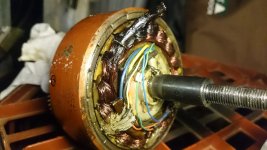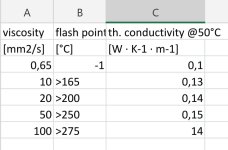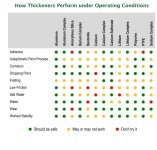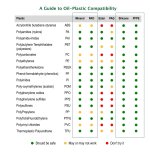Chalo
100 TW
Once you succeed at making e-bikes leaky and smelly, you can move on to figuring out how to make them emit toxic fumes and obnoxious noise.
Chalo said:Once you succeed at making e-bikes leaky and smelly, you can move on to figuring out how to make them emit toxic fumes and obnoxious noise.
xfrankie said:Low-viscosity dimethicone.
"Silicone oils are primarily used as lubricants, thermic fluid oils or hydraulic fluids. They are excellent electrical insulators[2] and, unlike their carbon analogues, are non-flammable.

Chart on page 1 shows 0.1346W/(m*K) @ 40C, better than silicone but worse than hexadecene, but really close enough not to matter.neptronix said:How do your other proposed liquids compare to opticool in thermal conductivity? ( they use a different metric i believe )
fatty said:Chart on page 1 shows 0.1346W/(m*K) @ 40C, better than silicone but worse than hexadecene, but really close enough not to matter.neptronix said:How do your other proposed liquids compare to opticool in thermal conductivity? ( they use a different metric i believe )




fatty said:Cool -- glad somebody else also thought of silicone oil.Yamarlo said:I'm now testing 100 cSt. So far no leaking, have not measured drag yet
I don't know how to model drag by viscosity. It may well be insignificant, but conceptually, lower viscosity = lower drag.
Please keep us posted.
Chalo said:Once you succeed at making e-bikes leaky and smelly, you can move on to figuring out how to make them emit toxic fumes and obnoxious noise.
Maybe not yet, but considering the known materials incompatibilities, it may just be a matter of time.DogDipstick said:I never leaked a drop
Excellent info. Tubeless sealant should have no effect.Yamarlo said:Current delta for idle full speed (~40 km/h, 305RPM) is about 0.2A @~41V,
comparing silicone oil 20cSt (1,1A) and 100cSt (1.3A) in a G310.
fatty said:And the consequences are significant: oil on brakes = no brakes, oil on tire = crash.
DogDipstick said:Millions of vehicles not leaking. On the road daily. I cannot imagine anything in the hub motor that would be incompatible with Atf.
Although i would welcome you doing more tests, were are only really speculating about long term compatibility. There are plenty of test regarding the cooling function.DogDipstick said:Speculation is all I really see here. IDK. Speculation is nothing compared to one good test. Get those numbers.
DogDipstick said:#2 was WD40. .... Any.. of yall... try WD40 in volume ( like a quart in a DDhub)?
Chalo said:The seals on cartridge bearings are for dust, not oil. That's why they're greased instead of oil lubricated. Please explain how you seal those against oil leakage while allowing them to turn.
DogDipstick said:Chalo said:The seals on cartridge bearings are for dust, not oil. That's why they're greased instead of oil lubricated. Please explain how you seal those against oil leakage while allowing them to turn.
I'll get the part number off one of the ( three ) hub motors I have here and I;ll look it up to find its intended application and design.
I do contest what you say. My qs motor(s) had a labyrinth seal(s) like a SKF just like the tailshaft of ta transmission or the crank pulley seal in a block. Garter spring, labyrinth, and two sealing surfaces. Just like most cars. THey are holding quite a large ( and draggy) volume of ATF for some time now. Probally 2/3 of a quart by now. I do nto know why you would think they are designed for dust only. They are pressure seals. At least in this manufacrurers. I am pulling a 205 apart soon to drill, fill and seal, for exposure to 400+ amps. Revving up 350A on the 273 made me want to do it. I am going to ride both motors on 400+A soon. Compare them myself.
Thankyou for your consensus thought on the damage and the record. I do not ( in my ways, ) think it is detrimental based on my schooling an knowledge. I will continue to do it. One good test is worth.... a thousan.. Oh nevermind.
I am absolutely willing to try the greasy WD in a hub from the start.. to see what happens.. if no one has done it yet.
All the obvious ones have been mentioned in this thread, except 3M Fluorinert and Novec.zzoing said:Cool thread guys! Very interested to know what products you are finding that have hi thermal conductivity and low-viscosity.
Knowing that silicone oil has better compatibility, you'd want to do the opposite: use hydrocarbon grease in the bearings, and silicone oil as coolant.zzoing said:If you grease the bearings with silicone teflon grease, that should make them a bit more resistance to ingress from light machine mineral oils.
$100 + $61 shipping (for me, at least) for 1 gallonzzoing said:$20 a litre will go very long way, considering you only need 100_200ml hub motor, that's 2 or 4 dollars.
Thermal grease is often silicone-based, which would be dissolved by silicone oil as the compatibility chart above. And since the hub plates aren't intended to seal liquids, they likely won't be machined well enough to seal without a curing bulk gap sealant.zzoing said:I recommend cheap CPU Grease to seal the hub plates, perhaps Colgate too. Expensive CPU grease can transfer 5 times more thermal energy, but the oil would probably be doing that anyhow...
I don't think you'd be able to get a watercooled motor past 100C. You'd have to be so deep into saturation that you're dumping amps purely into heat.zzoing said:Water can permeate into the hall sensors in a gas phase under pressure and it can cause slight corrosion to the iron parts including the bearing cans. It will we work though. You can make it very alkaline using some additives, calcium is an obvious one, enough to offset the effects of the ambient CO2 which turn it into an effective acid.
The water would evaporate as I go up mountains come I would have to refill it. It would work pretty well although I think that oil is durable and non-evaporative choice for me.
Usually hub disks which hold the cartridge bearings are reinforced so that the aluminium is higher near to the cartridge forming a dam when the hub is on it's side.Chalo said:The seals on cartridge bearings are for dust, not oil. That's why they're greased instead of oil lubricated.
